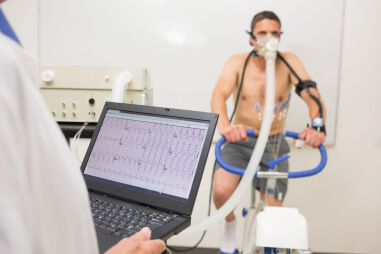A nuclear stress test is a diagnostic procedure that tests your heart at rest and after exercise, by injecting a small amount of radio tracer into a vein. Using a special camera know as a gamma camera, a technician produces computer images of the heart to discern areas where the heart muscle is damaged. The test is also called a Myocardial Perfusion Imaging (MPI) test.
Why Would Your Physician Order a Nuclear Stress Test?
When your physician thinks you might have coronary artery disease, he will first schedule a stress test that may show why you are exhibiting symptoms such as chest pain or shortness of breath. If the stress test does not solve the problem, he will then order a nuclear stress test to find the source of the problem. If you’ve already been diagnosed with a heart problem, this test can be useful as well.
Common reason why he or she might order the test include:
- To diagnose coronary artery disease, which often has symptoms of shortness of breath or chest pains as a result of the arteries being blocked, damaged, or diseased.
- To determine the size and shape of your heart, to see if it is enlarged and how it is pumping blood through your body.
- To guide the treatment of heart disorders such as coronary artery disease, arrhythmia, or other conditions.
How the Test is Done
The nuclear stress tests or MPI may use one of two techniques: a single photon emission computer tomography (SPECT) or a positive emission tomography (PET) test. The technician will take two sets of films that show your heart at rest and your heart after exercise so that the physician can compare them. Neither of these techniques show the arteries of the heart, but still give the physician a clear idea of whether arteries are blocked. He may then determine future treatment options, such as an angiogram, if the test is abnormal. If the results are normal, he might look at other causes for chest pain.
When you come to the test site, you will start a procedure that can last 2 to 3 hours and which includes 7 to 12 minutes of exercise. During the procedure, you will receive two doses of the tracer through an IV. During the procedure, your heart rate, EKG, and blood pressure will be constantly monitored.
Rest and Exercise
The test alternates periods of rest and exercise. For the exercise part of the test, the technician will first have you do physical exercise on a treadmill, which moves faster and at a greater incline as the test progresses. Alternatively, you may use a stationary bike with increasing resistance. If you cannot do these exercises and exhibit symptoms such as moderate to severe chest pain, severe shortness of breath, dizziness, abnormal heart rhythms, or abnormally high or low blood pressure, the technician will stop the test and you will be injected with medication that replicates the effect of exercise.
After the test, you should drink plenty of water to remove remaining traces of radiation from your system. However, you can resume your normal activities immediately and make an appointment with your cardiologist to find out the results of your test.
Check out Your Symptoms at Raintree Medical and Chiropractic Center
If you are exhibiting symptoms such as shortness of breath or chest pain, it’s time to make an appointment at Raintree Medical and Chiropractic Center. Our primary care providers will evaluate you and if necessary, conduct a nuclear stress test on you. To make an appointment, contact us at 816-623-3020 or via our website.

